25.09.2024

An aerial drone photo taken on Sept. 25, 2024 shows China's Five-hundred-meter Aperture Spherical Radio Telescope (FAST) under maintenance in southwest China's Guizhou Province. The construction of the Core Array of China's Five-hundred-meter Aperture Spherical Radio Telescope (FAST) started Wednesday, highlighting China's growing potential in global radio astronomy research. (Xinhua/Liu Xu)
The construction of the Core Array of China's Five-hundred-meter Aperture Spherical Radio Telescope (FAST) started Wednesday, highlighting China's growing potential in global radio astronomy research.
As a proposed extension of FAST, the Core Array integrates 24 secondary 40-meter antennas implanted within 5 kilometers of the FAST site, said Jiang Peng, deputy director of the National Astronomical Observatories under the Chinese Academy of Sciences.
The Chinese-designed array will combine the unprecedented sensitivity of FAST with a high angular resolution, thereby exceeding the capabilities at similar frequencies of next-generation arrays in the world.
The FAST Core Array is estimated to be completed and put into operation in 2027. ■

An aerial drone photo taken on Sept. 25, 2024 shows the groundbreaking ceremony for the construction of the Core Array of China's Five-hundred-meter Aperture Spherical Radio Telescope (FAST) in southwest China's Guizhou Province. The construction of the Core Array of China's Five-hundred-meter Aperture Spherical Radio Telescope (FAST) started Wednesday, highlighting China's growing potential in global radio astronomy research.
As a proposed extension of FAST, the Core Array integrates 24 secondary 40-meter antennas implanted within 5 kilometers of the FAST site, said Jiang Peng, deputy director of the National Astronomical Observatories under the Chinese Academy of Sciences.
The Chinese-designed array will combine the unprecedented sensitivity of FAST with a high angular resolution, thereby exceeding the capabilities at similar frequencies of next-generation arrays in the world.
The FAST Core Array is estimated to be completed and put into operation in 2027. (Xinhua/Liu Xu)
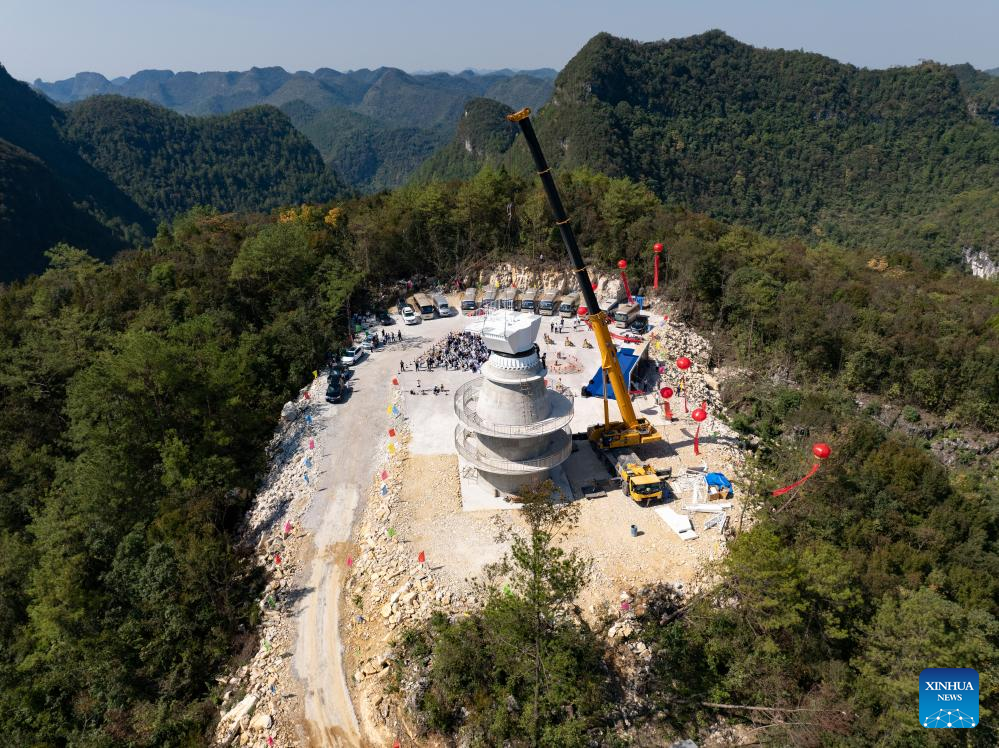
An aerial drone photo taken on Sept. 25, 2024 shows the first test prototype of the Core Array of China's Five-hundred-meter Aperture Spherical Radio Telescope (FAST) being installed in southwest China's Guizhou Province. The construction of the Core Array of China's Five-hundred-meter Aperture Spherical Radio Telescope (FAST) started Wednesday, highlighting China's growing potential in global radio astronomy research.
As a proposed extension of FAST, the Core Array integrates 24 secondary 40-meter antennas implanted within 5 kilometers of the FAST site, said Jiang Peng, deputy director of the National Astronomical Observatories under the Chinese Academy of Sciences.
The Chinese-designed array will combine the unprecedented sensitivity of FAST with a high angular resolution, thereby exceeding the capabilities at similar frequencies of next-generation arrays in the world.
The FAST Core Array is estimated to be completed and put into operation in 2027. (Xinhua/Liu Xu)
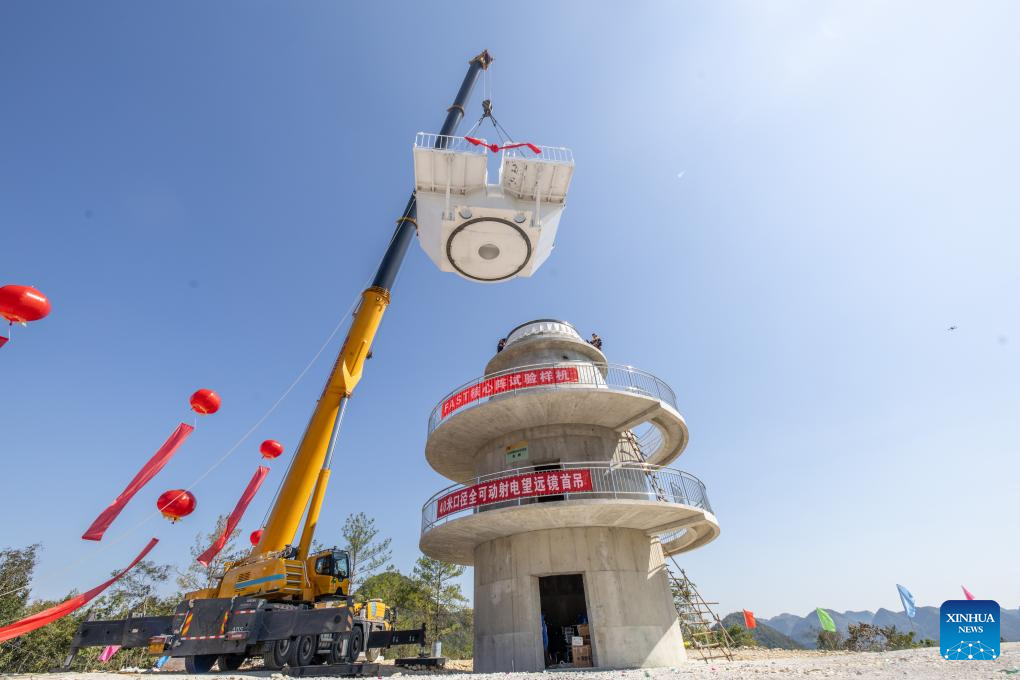
This photo taken on Sept. 25, 2024 shows the first test prototype of the Core Array of China's Five-hundred-meter Aperture Spherical Radio Telescope (FAST) being installed in southwest China's Guizhou Province. The construction of the Core Array of China's Five-hundred-meter Aperture Spherical Radio Telescope (FAST) started Wednesday, highlighting China's growing potential in global radio astronomy research.
As a proposed extension of FAST, the Core Array integrates 24 secondary 40-meter antennas implanted within 5 kilometers of the FAST site, said Jiang Peng, deputy director of the National Astronomical Observatories under the Chinese Academy of Sciences.
The Chinese-designed array will combine the unprecedented sensitivity of FAST with a high angular resolution, thereby exceeding the capabilities at similar frequencies of next-generation arrays in the world.
The FAST Core Array is estimated to be completed and put into operation in 2027. (Xinhua/Ou Dongqu)
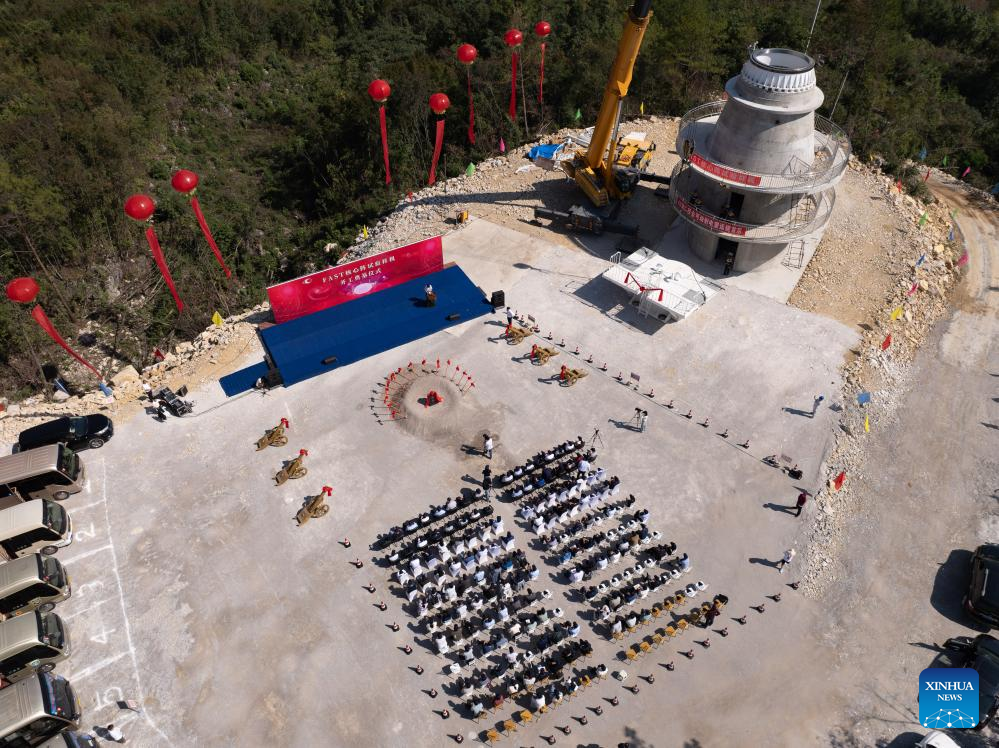
An aerial drone photo taken on Sept. 25, 2024 shows the groundbreaking ceremony for the construction of the Core Array of China's Five-hundred-meter Aperture Spherical Radio Telescope (FAST) in southwest China's Guizhou Province. The construction of the Core Array of China's Five-hundred-meter Aperture Spherical Radio Telescope (FAST) started Wednesday, highlighting China's growing potential in global radio astronomy research.
As a proposed extension of FAST, the Core Array integrates 24 secondary 40-meter antennas implanted within 5 kilometers of the FAST site, said Jiang Peng, deputy director of the National Astronomical Observatories under the Chinese Academy of Sciences.
The Chinese-designed array will combine the unprecedented sensitivity of FAST with a high angular resolution, thereby exceeding the capabilities at similar frequencies of next-generation arrays in the world.
The FAST Core Array is estimated to be completed and put into operation in 2027. (Xinhua/Liu Xu)

An aerial drone photo taken on Sept. 25, 2024 shows the newly installed first test prototype (up, R) of the Core Array of China's Five-hundred-meter Aperture Spherical Radio Telescope (FAST) and the FAST (up, L) in southwest China's Guizhou Province. The construction of the Core Array of China's Five-hundred-meter Aperture Spherical Radio Telescope (FAST) started Wednesday, highlighting China's growing potential in global radio astronomy research.
As a proposed extension of FAST, the Core Array integrates 24 secondary 40-meter antennas implanted within 5 kilometers of the FAST site, said Jiang Peng, deputy director of the National Astronomical Observatories under the Chinese Academy of Sciences.
The Chinese-designed array will combine the unprecedented sensitivity of FAST with a high angular resolution, thereby exceeding the capabilities at similar frequencies of next-generation arrays in the world.
The FAST Core Array is estimated to be completed and put into operation in 2027. (Xinhua/Liu Xu)

An aerial drone photo taken on Sept. 25, 2024 shows the first test prototype of the Core Array of China's Five-hundred-meter Aperture Spherical Radio Telescope (FAST) being installed in southwest China's Guizhou Province. The construction of the Core Array of China's Five-hundred-meter Aperture Spherical Radio Telescope (FAST) started Wednesday, highlighting China's growing potential in global radio astronomy research.
As a proposed extension of FAST, the Core Array integrates 24 secondary 40-meter antennas implanted within 5 kilometers of the FAST site, said Jiang Peng, deputy director of the National Astronomical Observatories under the Chinese Academy of Sciences.
The Chinese-designed array will combine the unprecedented sensitivity of FAST with a high angular resolution, thereby exceeding the capabilities at similar frequencies of next-generation arrays in the world.
The FAST Core Array is estimated to be completed and put into operation in 2027. (Xinhua/Liu Xu)

This undated simulated diagram shows the Core Array of China's Five-hundred-meter Aperture Spherical Radio Telescope (FAST) upon completion in southwest China's Guizhou Province. The construction of the Core Array of China's Five-hundred-meter Aperture Spherical Radio Telescope (FAST) started Wednesday, highlighting China's growing potential in global radio astronomy research.
As a proposed extension of FAST, the Core Array integrates 24 secondary 40-meter antennas implanted within 5 kilometers of the FAST site, said Jiang Peng, deputy director of the National Astronomical Observatories under the Chinese Academy of Sciences.
The Chinese-designed array will combine the unprecedented sensitivity of FAST with a high angular resolution, thereby exceeding the capabilities at similar frequencies of next-generation arrays in the world.
The FAST Core Array is estimated to be completed and put into operation in 2027. (Xinhua)
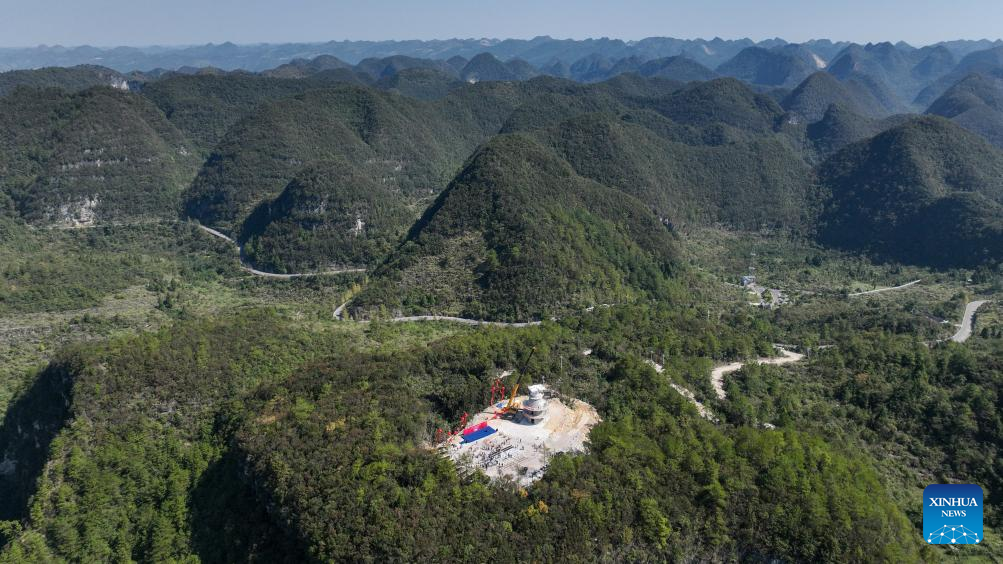
An aerial drone photo taken on Sept. 25, 2024 shows the first test prototype of the Core Array of China's Five-hundred-meter Aperture Spherical Radio Telescope (FAST) being installed in southwest China's Guizhou Province. The construction of the Core Array of China's Five-hundred-meter Aperture Spherical Radio Telescope (FAST) started Wednesday, highlighting China's growing potential in global radio astronomy research.
As a proposed extension of FAST, the Core Array integrates 24 secondary 40-meter antennas implanted within 5 kilometers of the FAST site, said Jiang Peng, deputy director of the National Astronomical Observatories under the Chinese Academy of Sciences.
The Chinese-designed array will combine the unprecedented sensitivity of FAST with a high angular resolution, thereby exceeding the capabilities at similar frequencies of next-generation arrays in the world.
The FAST Core Array is estimated to be completed and put into operation in 2027. (Xinhua/Ou Dongqu)
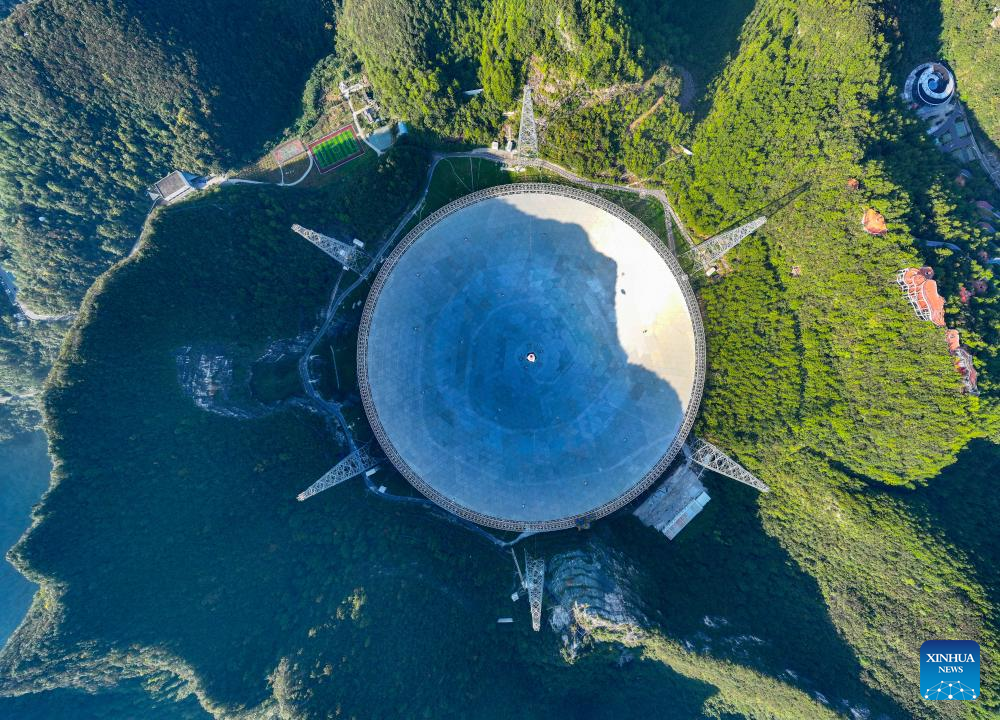
An aerial drone photo taken on Sept. 25, 2024 shows China's Five-hundred-meter Aperture Spherical Radio Telescope (FAST) under maintenance in southwest China's Guizhou Province. The construction of the Core Array of China's Five-hundred-meter Aperture Spherical Radio Telescope (FAST) started Wednesday, highlighting China's growing potential in global radio astronomy research.
As a proposed extension of FAST, the Core Array integrates 24 secondary 40-meter antennas implanted within 5 kilometers of the FAST site, said Jiang Peng, deputy director of the National Astronomical Observatories under the Chinese Academy of Sciences.
The Chinese-designed array will combine the unprecedented sensitivity of FAST with a high angular resolution, thereby exceeding the capabilities at similar frequencies of next-generation arrays in the world.
The FAST Core Array is estimated to be completed and put into operation in 2027. (Xinhua/Liu Xu)
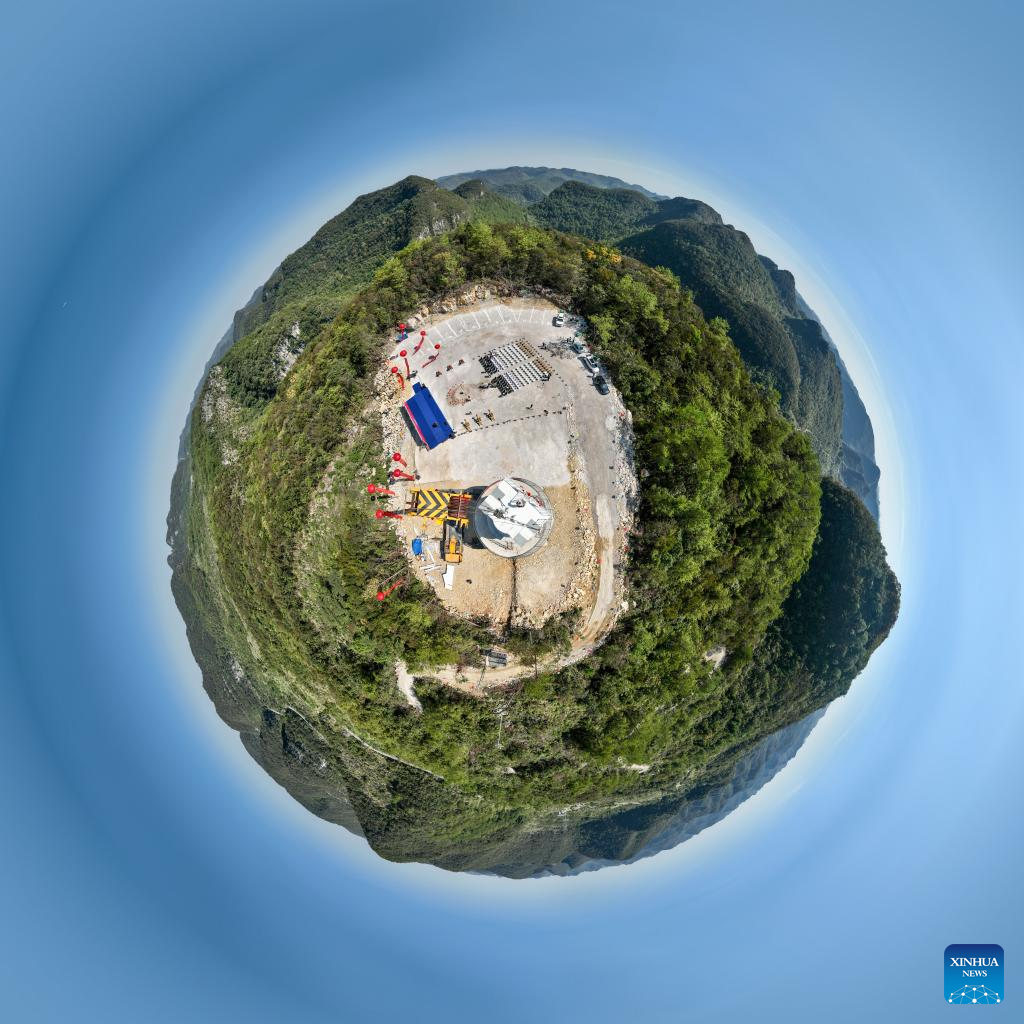
An aerial panoramic photo taken on Sept. 25, 2024 shows the first test prototype of the Core Array of China's Five-hundred-meter Aperture Spherical Radio Telescope (FAST) being installed in southwest China's Guizhou Province. The construction of the Core Array of China's Five-hundred-meter Aperture Spherical Radio Telescope (FAST) started Wednesday, highlighting China's growing potential in global radio astronomy research.
As a proposed extension of FAST, the Core Array integrates 24 secondary 40-meter antennas implanted within 5 kilometers of the FAST site, said Jiang Peng, deputy director of the National Astronomical Observatories under the Chinese Academy of Sciences.
The Chinese-designed array will combine the unprecedented sensitivity of FAST with a high angular resolution, thereby exceeding the capabilities at similar frequencies of next-generation arrays in the world.
The FAST Core Array is estimated to be completed and put into operation in 2027. (Xinhua/Ou Dongqu)
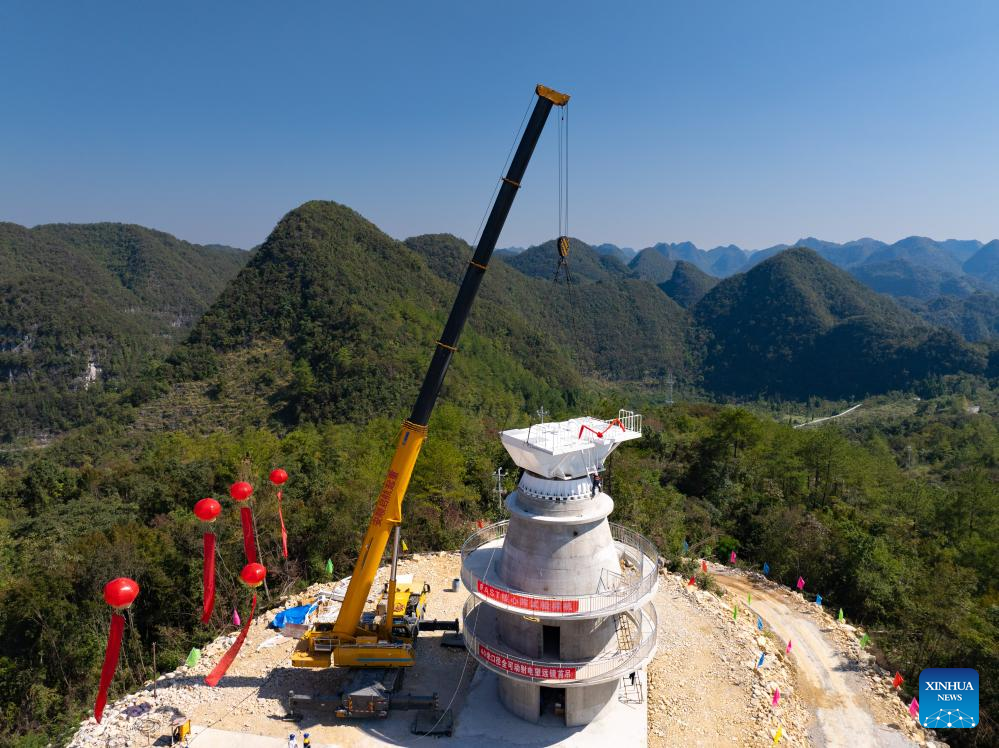
An aerial drone photo taken on Sept. 25, 2024 shows the first test prototype of the Core Array of China's Five-hundred-meter Aperture Spherical Radio Telescope (FAST) being installed in southwest China's Guizhou Province. The construction of the Core Array of China's Five-hundred-meter Aperture Spherical Radio Telescope (FAST) started Wednesday, highlighting China's growing potential in global radio astronomy research.
As a proposed extension of FAST, the Core Array integrates 24 secondary 40-meter antennas implanted within 5 kilometers of the FAST site, said Jiang Peng, deputy director of the National Astronomical Observatories under the Chinese Academy of Sciences.
The Chinese-designed array will combine the unprecedented sensitivity of FAST with a high angular resolution, thereby exceeding the capabilities at similar frequencies of next-generation arrays in the world.
The FAST Core Array is estimated to be completed and put into operation in 2027. (Xinhua/Liu Xu)
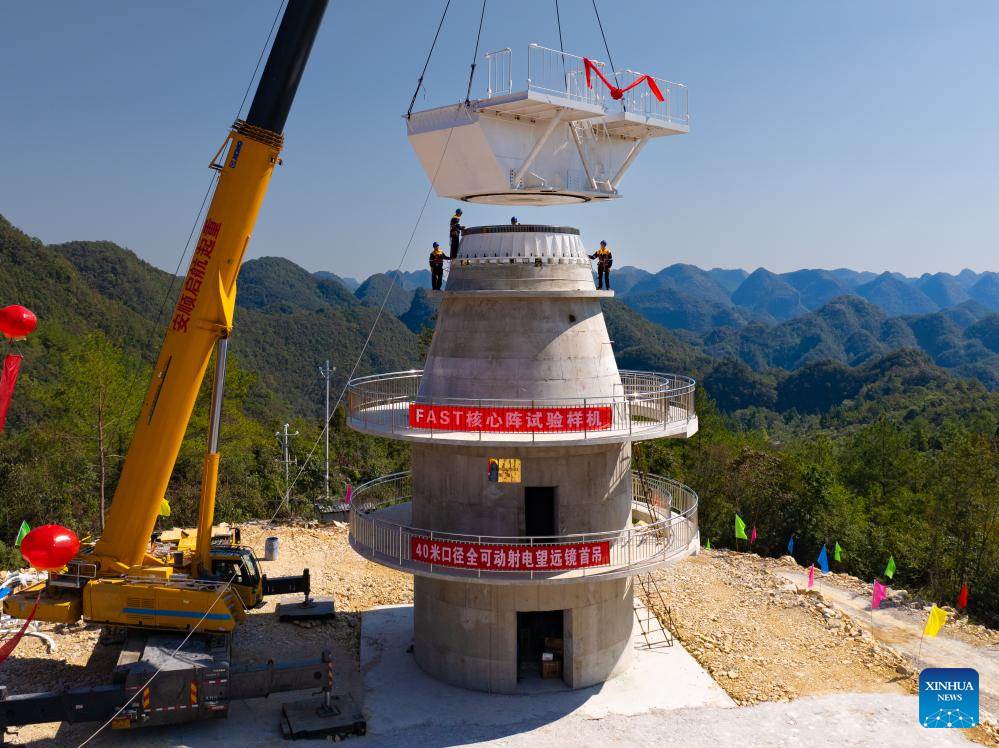
A drone photo taken on Sept. 25, 2024 shows the first test prototype of the Core Array of China's Five-hundred-meter Aperture Spherical Radio Telescope (FAST) being installed in southwest China's Guizhou Province. The construction of the Core Array of China's Five-hundred-meter Aperture Spherical Radio Telescope (FAST) started Wednesday, highlighting China's growing potential in global radio astronomy research.
As a proposed extension of FAST, the Core Array integrates 24 secondary 40-meter antennas implanted within 5 kilometers of the FAST site, said Jiang Peng, deputy director of the National Astronomical Observatories under the Chinese Academy of Sciences.
The Chinese-designed array will combine the unprecedented sensitivity of FAST with a high angular resolution, thereby exceeding the capabilities at similar frequencies of next-generation arrays in the world.
The FAST Core Array is estimated to be completed and put into operation in 2027. (Xinhua/Liu Xu)
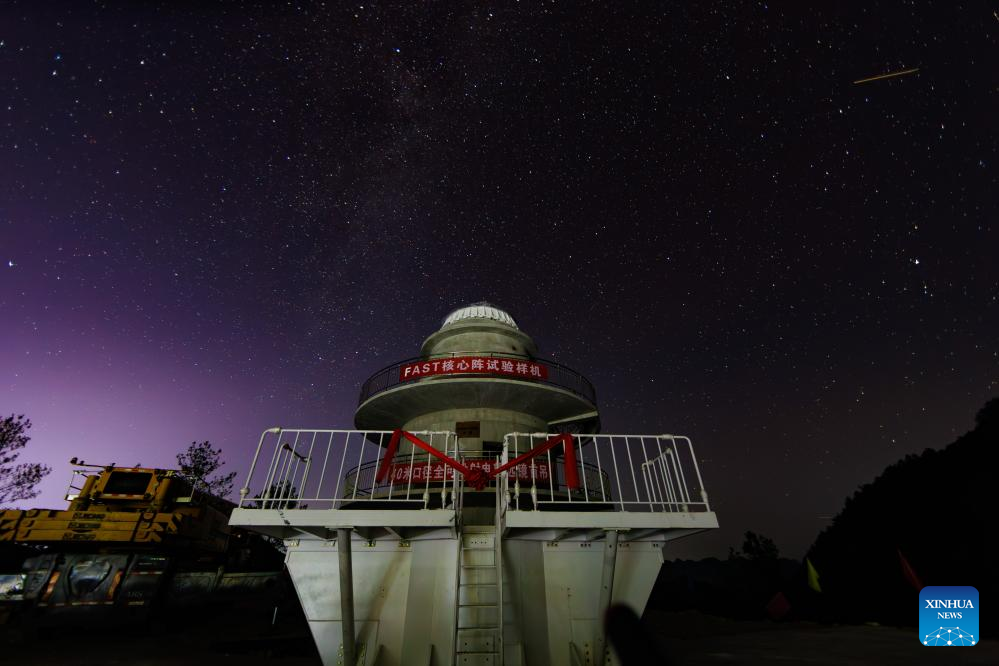
A drone photo taken on Sept. 24, 2024 shows the first test prototype of the Core Array of China's Five-hundred-meter Aperture Spherical Radio Telescope (FAST) waiting to be installed in southwest China's Guizhou Province. The construction of the Core Array of China's Five-hundred-meter Aperture Spherical Radio Telescope (FAST) started Wednesday, highlighting China's growing potential in global radio astronomy research.
As a proposed extension of FAST, the Core Array integrates 24 secondary 40-meter antennas implanted within 5 kilometers of the FAST site, said Jiang Peng, deputy director of the National Astronomical Observatories under the Chinese Academy of Sciences.
The Chinese-designed array will combine the unprecedented sensitivity of FAST with a high angular resolution, thereby exceeding the capabilities at similar frequencies of next-generation arrays in the world.
The FAST Core Array is estimated to be completed and put into operation in 2027. (Xinhua/Liu Xu)
Quelle: Xinhua
